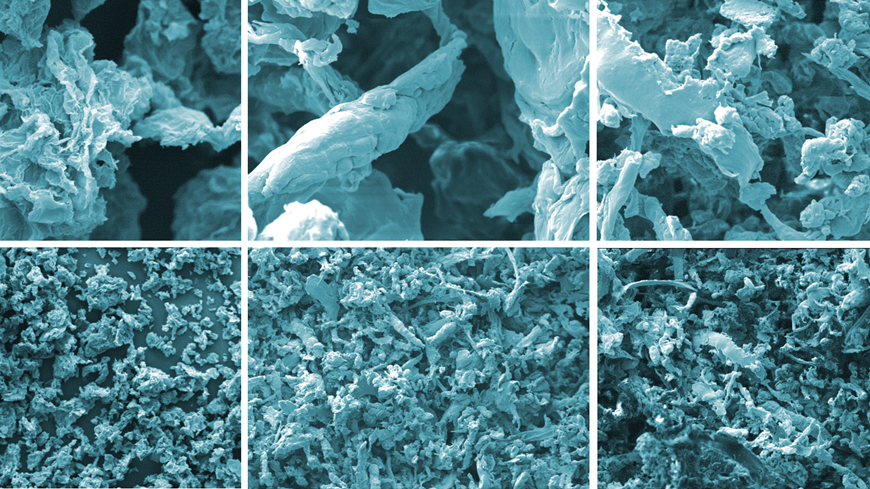The health consequences of graphene-based particles produced from polymer composites following abrasion are insignificant. An international research group of the Graphene Flagship project did a study on the health hazards of graphene-containing nanoparticles under the supervision of Empa.
 Graphene Flagship researchers analyzed the effect of particles derived from polyamide reinforced with reduced graphene oxide. Colored SEM images of abraded particles. Image Credit: Empa/Journal of Hazardous Materials.
Graphene Flagship researchers analyzed the effect of particles derived from polyamide reinforced with reduced graphene oxide. Colored SEM images of abraded particles. Image Credit: Empa/Journal of Hazardous Materials.
The results were recently published in the Journal of Hazardous Materials.
Reinforcement of polymers using graphene-related materials (GRMs) is common. GRMs can substantially improve the strength, electrical conductivity, and thermal transport of composites in modest concentrations of up to five weight percent for a range of applications.
However, since graphene and GRMs are a relatively new class of materials, they must be thoroughly evaluated before commercialization to discover any potential negative consequences.
In a new study, an interdisciplinary team of scientists led by the EU’s Graphene Flagship project developed a composite of polyamide 6 (PA6, also known as Nylon-6) — a thermoplastic polymer used in a variety of industries including automotive and sports equipment — and 2.5% reduced graphene oxide (rGO), a form of graphene that improves the polymer’s reinforcement.
The material was then abraded to produce particles with an average diameter of 1.9 μm for rGO-PA6 and 3.2 μm for pure PA6, imitating future processing or end-of-life events.
Airborne Materials
Throughout the most likely exposure pathways, the researchers studied and contrasted the impacts of abraded particles containing either PA6-rGO, PA6 alone, or pure rGO. As a result, they employed cell-based models of human lungs, gastrointestinal tract, skin, and immune system, as well as pulmonary exposure in vivo mouse models.
In the various cell-based models, the researcher discovered relatively minimal acute responses following exposure to PA6-rGO. Only rGO had significant side effects, especially in macrophages, a kind of immune cell.
The scientists did a single exposure trial in mice since inhalation of airborne pollutants is a major occupational hazard. PA6-rGO caused a mild and temporary lung inflammation, which was consistent with the acute in vitro results.
Overall, this thorough analysis demonstrates that acute rGO-PA6 exposure poses a modest risk to human health. However, further research is needed to determine the long-term consequences or influence on people with chronic obstructive pulmonary disease (COPD) or asthma.
We aim to anticipate the ‘what if?’ scenario prior to the broad use of these emerging materials to avoid future social and economic drawbacks. We anticipated questions, which will become relevant for the ‘Chemicals Strategy for sustainability towards a toxic-free environment’ of the European Commission, facilitating the safe and sustainable use of GRM-reinforced materials.
Peter Wick, Study Lead Author and Scientist, Empa
Wick added, “This was only possible thanks to a multidisciplinary team of experts in polymers, graphene, and nanosafety, favored by the Graphene Flagship ecosystem.”
This comprehensive study of possible toxicity of graphene-polymer composite fragments highlights the central role that health and safety plays in the Graphene Flagship since its very beginning.
Andrea C. Ferrari, Officer, Science and Technology, Graphene Flagship
Ferrari stated, “When these composites are processed into industrial parts, one needs to seriously consider the possible health implications due to emitted/abraded particles. It is reassuring to see this study shows negligible effects, thus confirming the viability of graphene for mass applications.”
Journal Reference:
Chortarea, S., et al. (2022) Hazard assessment of abraded thermoplastic composites reinforced with reduced graphene oxide. Journal of Hazardous Materials. doi:10.1016/j.jhazmat.2022.129053.